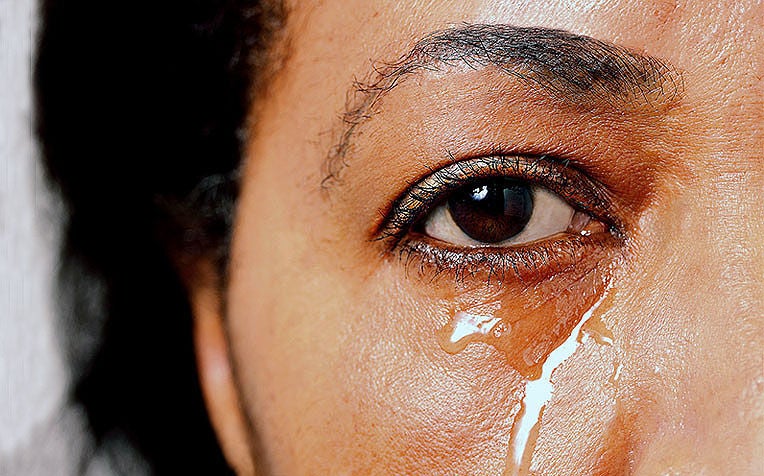
Watery eyes (epiphora) usually clears up on its own and are often caused by allergens and eye fatigue.
If you think that tears are produced only when you are emotional (sad, happy, angry etc.), think again.
Those are emotional tears, but there are also basal tears and irritant tears. Tears are produced constantly to help moisten the eye (basal tears) and wash out any foreign object or particle (irritant tears, hence the name!), keeping the front surface healthy and maintaining clear vision, but too many tears can impact your vision, making it difficult for you to see.
"Watery eyes, also known as epiphora, occurs when one or both eyes produce excessive tears or have problem draining tears. It is a common condition that often clears up on its own. However, treatment may be required if the condition persists and impacts your daily activities," advises our specialists from the Oculoplastic Department at Singapore National Eye Centre (SNEC), a member of the SingHealth group.
5 Tips to prevent your eyes from tearing too much
1) Avoid use of expired eye make-up
Dispose of old eye make-up and replace your mascara and eye shadow every three months. Make it a point to regularly clean your eye make-up applicators. Old or expired make-up can potentially cause eye infections and can precipitate or worsen your watery eye condition.
2) Beware of allergens
Avoid contact with allergens to reduce chances of tearing. Allergens include:
Dust mites
Pollen, and
Fumes
If you are wearing contact lenses, try switching to daily disposable contact lenses to cut down on allergen build-up on your lenses.
3) Take regular eye breaks
Prolonged usage of digital devices often leads to eye fatigue, resulting in blurred vision, watery and,at times, dry eyes. Your eyes tend to blink less often when looking at a screen or when engaged in an activity.
Remember the 20-20-20 rule – take a 20 second break by looking at an object that is 20 feet away every 20 minutes.
4) Don't rub, use eye drops instead
Use artificial tears or lubricating eye drops to lubricate your eyes if you notice your eyes are dry.
5. See your eye doctor
Consult an eye doctor for further evaluation if you experience any symptoms of watery eye for a thorough examination.
Treating the 7 common causes of watery eyes
Watery eyes can be triggered by several reasons. Here is what you can do to help relieve the constant flow of tears that is affecting your daily life.
a) Allergy
Exposure to irritants such as pollen, dust mites and fumes can make your eyes red, itchy and watery. Try eye drops and antihistamines for relief, which can be purchased easily from the pharmacy without a doctor’s prescription.
b) Dry Eye
Extreme dry eye can irritate your eye causing it to produce excess tears. Common symptoms include stinging, burning or scratchy sensation in your eyes, excessive watering, and blurred vision.
Artificial tears or prescription medication can help alleviate the symptoms. Treatment for more severe cases may include steroids, punctal occlusion or surgery.
c) Conjunctivitis or red eye
Conjunctivitis is the inflammation of the thin, translucent tissue (the "conjunctiva") that lines the white part of the eye. It is commonly caused by a bacterial or viral infection or an allergic reaction.
You may experience redness; swelling of the conjunctiva; itching, irritation and/or burning; discharge; or crusting of the eyelids or lashes, especially in the morning. See a doctor for treatment if it does not resolve or worsens despite initial topical treatment.
d) Blocked tear ducts
This occurs when your tear passageway leading from the eye into the nose is blocked, causing tears to build-up, resulting in excessive tearing. Other common symptoms may include pain and swelling; redness and irritation of the affected eye; crusting of the eyelids, blurred vision; mucus or pus discharge from the eye.
Treatment may include symptomatic treatment of tearing eyes with formal investigation to check for patency of the tear ducts. Surgery may be indicated in severe cases.
e) Sagging or abnormal positioning of the eyelids
If your eyelid sags and affects the eyelid margin position, your eyes can get watery as the tears cannot drain normally. If the eyelid grows inwards, it rubs your eye and irritates it.
Your doctor may recommend artificial tears or lubricating ointment to help moisten the eye and to relieve discomfort. Tape can sometimes be used to temporarily reposition the eyelid in cases where it is directed inwards. In severe cases, surgery may be required to reposition the eyelid back to its normal position.
f) Styes
These painful white or reddish bumps that form on your eyelid can also cause eyes to water. It is usually caused by bacteria and will go away on its own in about a week. Applying a warm compress on the eye for 10 to 15 minutes three to four times a day can help liquify the hardened material in a stye, allowing it to drain and ease the pain.
g) Keratitis
Keratitis, also known as corneal ulcer, is an inflammation or irritation of the cornea, the clear outer layer at the front of the eye. It may or may not be associated with an infection. Non-infectious keratitis can be caused by a minor injury such as wearing of contact lenses for prolong period or foreign body in the eye, whilst infectious keratitis can be caused by bacteria, viruses, fungi or parasites.
When to see a doctor
See a doctor immediately for treatment if your eye is:
Watery,
Painful,
Red, and
Highly sensitive to light
Treatment regime will usually commence with your doctor administering antibacterial, antiviral or antifungal eye drops in the affected eye follow by anti-inflammatory drops.
With our handy tips, we hope that the only reason you get watery eyes from now on is getting emotional over your favourite drama series!
Ref: H24
Check out other eye care articles:
11 Ways to Maintain Good Eyesight
Contributed by


















 Get it on Google Play
Get it on Google Play